| |

MACHINES IN THE CITY
Jeffrey Wasserstrom
Balloons, Trains, & Horse-Drawn Coaches:
The Dianshizhai & Jules Verne
The era of the Dianshizhai was, in some ways, an era much like our own. It was a time of rapid technological changes, which generated a mixture of excitement and worry, linked to issues such as increases in speed and potential for violence associated with novel machines and devices.
More specifically, the second half of the 19th century was a period, like the last five decades have been, when the creation or increased use of novel machines dramatically altered such fundamental aspects of life as the way people communicated, traveled, fought wars, and recorded and shared things that they were doing. Much that has been said about the Internet was once said about the telegraph, which in its early years was also called a technology that “annihilated time and space” in exhilarating ways. The notion that drones depersonalize killing has parallels in commentaries on armed gunboats and Gatling guns.
The way that the transformative effects of new jet-plane routes and freeways have been discussed echoes much that was once said of balloons that could cross vast expanses of land without touching down—and of long distance trains, that could take passengers and freight further and faster than previously had been imaginable. The thrill and mystery of capturing the look of events on video cameras had a precedent then in the fascination with the first cameras. And so on.
The wondrous machines of the 19th century did not always make it to China immediately, but when they did arrive, it was often to Shanghai; and Shanghai publications played crucial roles in spreading news of them even before they arrived.
Before zeroing in on Shanghai as a point of arrival for new machines and a center for publications describing and portraying them, it is worth asking two questions. First, how were visions of technological breakthroughs disseminated in the West? And what links or parallels can be drawn between these modes of dissemination and the ways that Chinese audiences might have been exposed to the same news? Many residents of even the most prosperous and technologically advanced parts of Western Europe and North America only had limited direct experience of some of the latest technological marvels. How did they learn about such developments in an era that predated not only the Web but also television?
One way was by visiting World’s Fairs, such as the great Crystal Palace show of 1851, the Philadelphia Centennial Exhibition of 1876, and the various Parisian Universal Expositions, such as the 1881 one for which the Eiffel Tower was built. These were the most important mass events of the time. They routinely included displays of everything from massive artillery pieces to less martial kinds of inventions, with photography and the first films gaining broad audiences at events of this kind. Millions of people visited the largest of these fairs—and many more went to smaller local version of them. Failing even that, they at least saw line drawings of their displays in newspapers, magazines, or richly illustrated catalogues and guides to the fairs. The latter served the function of virtual visitation of a site now provided by websites and National Geographic documentaries. Some of the guidebooks covered entire fairs. Others focused on specific sorts of machines.
|
|
 |
| |
Electrical Industries, “Weekly World’s Fair Supplement,”
Chicago, June 15, 1893
(detail right)
Source: OpenLibrary.org [view]
[dz507]
|
|
| |
China did not host a World’s Fair until 2010, by which time these events were typically called “World Expos” and were generally seen as less important global gatherings than the Olympics. Illustrated guides to European and North American World’s Fairs do not seem to have circulated in Shanghai in the era of the Dianshizhai. Still, there is an “old Shanghai” side to the World’s Fair dissemination story in the form of A New Account of a Trip Around the Globe, an 1878 book published in Shanghai that recounts the travels of Li Gui, who began and ended his world tour from that city.
Li’s book, [1] which has been ably translated by Charles Desnoyers, is filled with descriptions of the “advances and novelties” he saw in various distant lands. His journey included stops at the then-state-of-the-art London telegraph office and trips on awe-inspiring routes such as the just-opened American transcontinental railroad, but he was most struck by the technologies he observed at the Philadelphia Centennial Exhibition. The main goal of his global circuit was to observe the displays of this early World’s Fair—the first ever held outside of Europe, and the largest to date. Recounting his response to the Centennial Exhibition, Li was awestruck; its display of “machinery was immense,” with “so many” devices that it “was impossible to count” them all.
In ways that presage some writings now about computers, Li wrote of feeling that he was living in a new kind of age, when there “is now probably nothing done without the aid of machines. That which creates the machine is a machine; that which drives the machine is also a machine. To this one must now proclaim the state of the cosmos to be that of one vast machine.” (p. 118)
Another way that people in the West learned of this new age of mechanical marvels was by seeing them portrayed in the pages of periodicals such as the Illustrated London News. This periodical’s influence on the Dianshizhai has already been noted, so nothing more will be said about it now. Additionally, information also circulated via fiction—most influentially through the enormously popular novels of Jules Verne.
Perhaps no single individual did more to spread word of novel inventions and to depict their exhilarating and dangerous aspects than Verne. His best known works—such as Around the World in Eighty Days (1873), 20,000 Leagues Under the Sea (1869), and A Journey from the Earth to the Moon (1865)—sold briskly not only in French but also in English and other translations. They dealt with machines already in existence (trains, steamships, etc.) as well as ones that seemed likely to be created soon (rockets, for example). This was true also of many of his lesser known works, such as Five Weeks in a Balloon (1863) and Tribulations of a Chinese Gentleman (1879). (Although balloon travel is featured in the film version of Around the World in Eighty Days, it does not figure in the original novel.)
|
|
| |
Tribulations of a Chinese Gentleman is Verne’s Shanghai. The protagonist in this novel, an unusually progressive Chinese man, is an avid early adopter of the latest devices being developed in the West—intensely interested in “boats of great speed,” lighting his house with gas, and setting up telephone communication between the different rooms in his home (see especially page 50).
|
|
Les Tribulations d’un Chinois en Chine, published 1879, selected pages from 56 illustrations by Léon Benett
Image source:
The Illustrated Jules Verne website
[view]
|
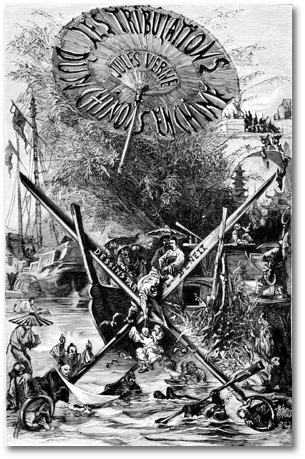 |

|
 |
| |
By the early 1900s, Verne’s works would begin to shape Chinese understandings of the excitement and terrors of modernity. For example, the first major work by China’s most influential 20th-century literary figure, Lu Xun, was a translation of A Journey from the Earth to the Moon. Though now not as widely read as Around the World in Eighty Days, this was a particularly interesting work in terms of already-extant as well as not-yet-created technologies. It reminds us of how connected breakthroughs in travel and in weaponry sometimes were. The author assumes Americans will reach the moon first, since the development of rockets will follow on the heels of the advanced guns that Americans had shown skill in creating during the country’s bloody Civil War.
In the late 1800s, though, before Verne’s works made their mark on China, the Dianshizhai arguably played a role in China comparable to that Verne’s novels played in the West. Its illustrations often showed people using new machines to do various things, including get from place to place in novel ways for peaceful or warlike reasons. These images sometimes depicted parts of the world other than China, such as Japan, where many new machines made inroads before reaching the Chinese mainland. One such graphic, for example, depicts a train in Japan waiting to transport soldiers returning from combat in Taiwan, where many were wounded.
|
|
| |
More often, though, the Dianshizhai’s objects of fascination were already in China, most often Shanghai. This comes through clearly in Ye Xiaoqing’s book, The Dianshizhai Pictorial: Shanghai Urban Life 1884-1898, which is filled with discussion of the attention paid to a variety of technological imports that were transforming ordinary life, such as big outdoor clocks (pp. 72-74) and gas and electric lighting (pp. 53-57—portrayed as something that brought both improvements and dangers), or showing up to offer special kinds of adrenalin-boosting diversions (for instance, the roller coaster that is portrayed on page 90).
There are several notable parallels between presentation of new technologies in Verne’s novels and the Dianshizhai. One is simply that some of the same vehicles and other machines show up in each text, likely providing some readers with the first descriptions and also, perhaps, their first visual representations of them. Trains, balloons, and submarines—all are featured in Verne’s works of fiction and in the Dianshizhai.
|
|
| |
“A New Type of Balloon”
新樣氣球
1884 (Vol. 1, p.6)
Roman letters on the balloon read “Saladin,” and passengers appear to be surveying Chinese fortifications. Ships and a fort in the foreground display French flags. What looks like a small steam ship or an ironclad steams up the river between the two camps.
Yale 1.008 [dz_v01_008]
Translated caption:
“A new type of balloon.
Although ‘superb craftsmanship’ remained no more than a proverb in the past, it has been achieved nowadays. During the Franco-Prussian War, balloons were employed for spying. While balloons used to be made of leather, this type of balloon, reportedly, is instead composed of superior woven silk...”
[View caption & English translation] |
|
| |

A second parallel involves the tendency for new machines to be introduced with enthusiasm, but also with nods to the risks that come with them and the connections they often have with warfare or violence of some kind. In the Dianshizhai as in some of Verne’s work (and in the displays of massive artillery pieces in World’s Fairs of the time), the violent side of the era is obvious. Images show weaponry either being deployed or simply being ogled at, as in an illustration depicting large cannons being climbed on as well as looked at by curious Chinese.
|
|
| |
Translated caption:
“Enormous Cannons for Frontier Defense.
Eight enormous cannons made in Armstrong and several hundred piles of bullets, all purchased by China, are loaded on J. J. Buchheister & Co.’s vessel Madras, which has just arrived in Shanghai from abroad. Lately, the weaponry has been unloaded on Xiahai beach and stored on the wharf of Gonghexiang. One cannon weights about 40 tons (?), and one would realize how heavy it is by the fact that the hull rose a little after each cannon was unloaded ashore. It is reported that these cannons will be transported to the Wusong port as well as other ports of the Yangzi River for the purpose of frontier defense. Good work! To prepare beforehand is a sign of effective government.
Translation by Flora Shao
|
|
| |
We find the same sort of scenes in Western photos such as the following, depicting visitors to an 1893 exhibition of Krupp artillery.
|
|
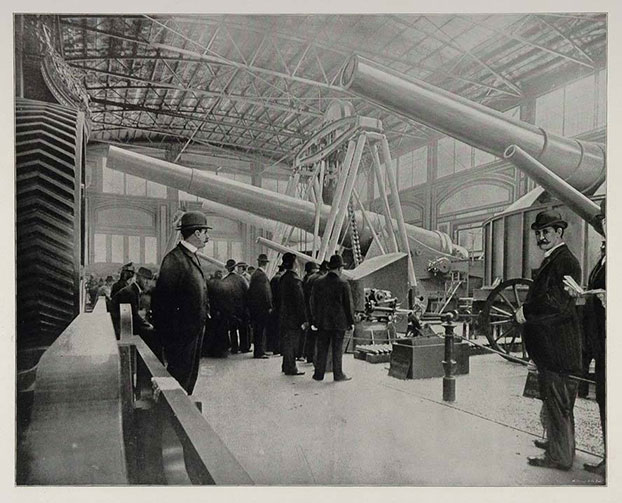 |
|
Exhibit of Krupp’s Guns at the Chicago World’s Fair, 1893
[dz511]
|
|
| |
The same exhibition of ominous new weaponry is to be found in a Dianshizhai depiction of a machine gun (literally here a “magic quick gun”) displayed in a Chinese garden:
|
|
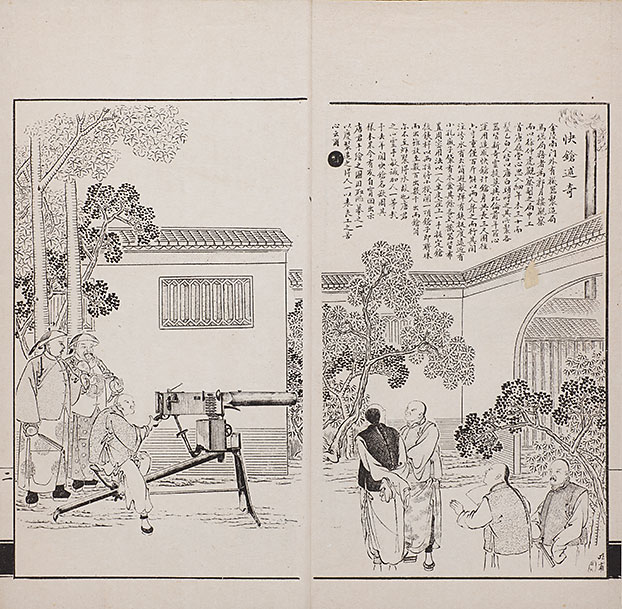 |
|
 “A Magic Quick Gun” “A Magic Quick Gun”
快枪述奇
ca. 1891 jin (Vol. 23, p. 2)
Yale 23.003 [dz_v23_003]
|
|
| |

Translated caption:
“A magic quick gun.
The engineering bureau is located outside the south gate of Jinling, and Guo Yuelou, the circuit intendant, serves as its chief and Xu Zhonghu, another circuit intendant, the associate chief. Tang Lütang, the foreman in the bureau, is a man of extreme meticulousness and, with his hair turning grey while not yet in his thirties, is addressed by everyone as ‘Mr. Tang the white head.’ All the instruments he made are so innovative and convenient that they are beyond comparison. The year before last, he showed his ingenuity again by making a quick gun...”
[View caption & English translation]
Translation by Alex Wang
|
|
| |
In the case of Dianshizhai, the risk factor of modern marvels is also sometimes tied to the uneasy relationship between old and new conveyances, as well as to the dangers of recently imported ones. There are many images of horse-drawn coaches or rikishaws being involved in accidents, for example.
|
|
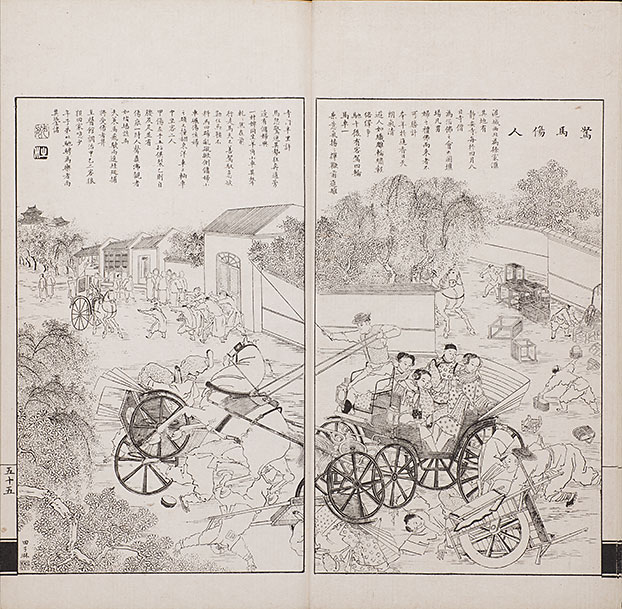 |
|
“Inferior Horse Hurts People” 駑馬傷人
1885 ding (Vol. 6, p. 6)
Yale 6.008 [dz_v06_008]
|
|
| |
Translated caption:
“Inferior Horse Hurts People
Northwest of Shanghai is Xujiahui, where Temple Jing’an is located. Every year on the eighth day of the fourth month, the temple’s monks hold a celebration of the Buddha’s Birthday Festival with grandiose platforms for Buddhist preaching. Numberless men and women come to pay their respect to the Buddha by burning incense. ... ”
[View caption & English translation]
Translation by Alex Wang
|
|
| |
Dangers may come with the modern world portrayed by Jules Verne and by the Dianshizhai, but excitement often trumps anxiety in both. Sympathy lies with those who are ready to embrace foolishly new technologies, even if cautiously and warily. This is the prevailing message in works by Verne such as Around the World in Eighty Days and in texts like that accompanying the graphic of a train (shown previously in chapter 2):
|
|
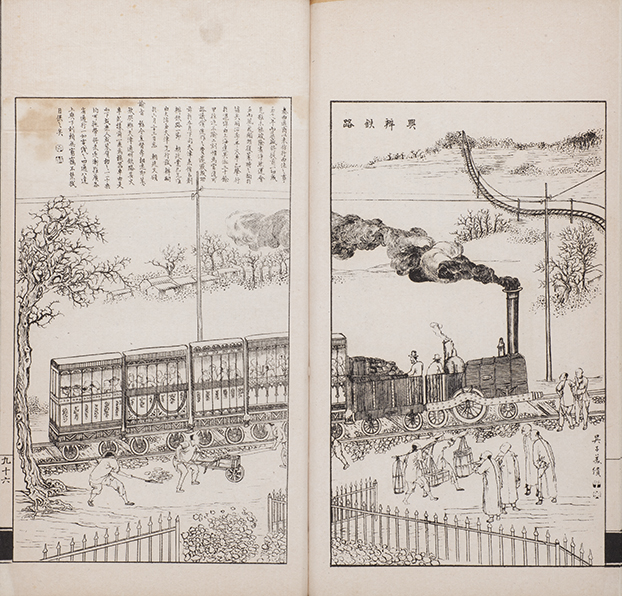 |
|
“...With their gradual promotion in other provinces, railways, like electric wires leading everywhere, will eventually run through the whole land without obstacles. I cannot help looking forward to the arrival of that day.”
“Launching the Railway”
興辦鐵路
1884 (Vol. 2, p. 46)
[View caption &
English translation]
Yale 2.048 [dz_v02_048]
|
|
| |
Additional images include two more images of conveyances, a second image linking trains to danger and one linking ships to danger.
|
|
| |
Other images remind us that sometimes smooth-working and non-threatening machines do new things, as in the image of the train above, another of scuba diving, and one of a balloon. Dianshizhai offers a show of conveyances either mixed with danger or offering some of those 80 ways of getting around and exploring the world via novel means.
|
|
|





